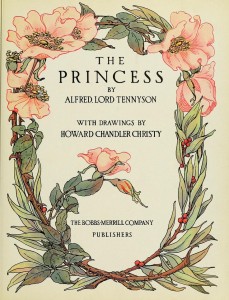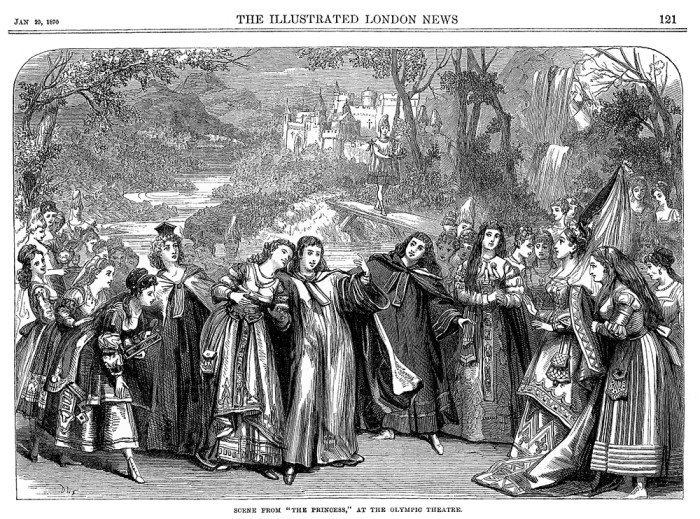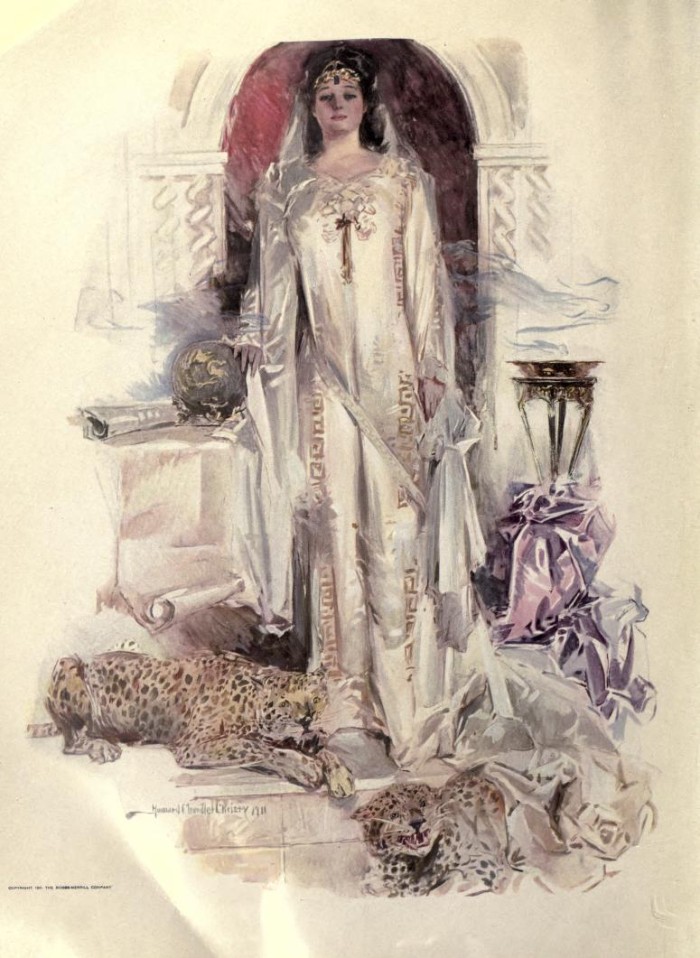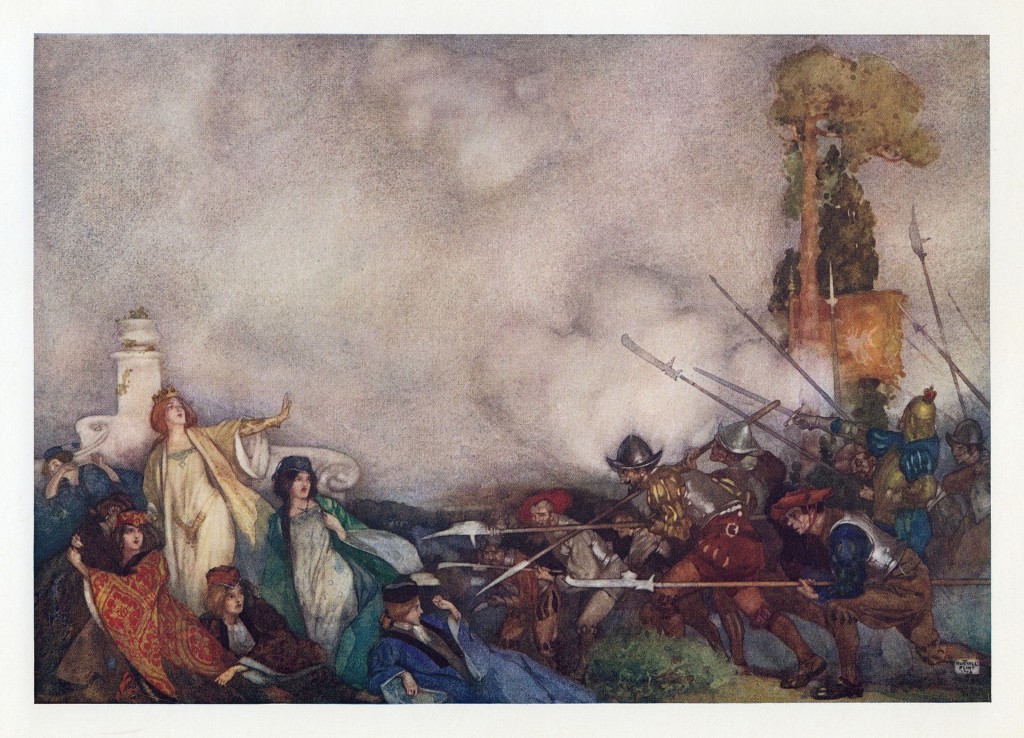If you’ve seen Princess Ida, you probably know that it presents some challenges. It can be funny and charming, but its plot structure seems disjointed, and its ending is a jarring deus-ex-machina that leaves many viewers scratching their heads.
Compared to every Gilbert & Sullivan show which preceded it, Ida is a mystery. After producing such tightly-plotted classics as HMS Pinafore, The Pirates of Penzance, and Iolanthe, how could Gilbert & Sullivan have loosened their standards so far? Were they rushed? Having a bad year?
Or is it that the perplexities of Ida have something to do with the passage of time, and a change of culture?
In 2011, I stage-directed a production of Princess Ida for the student group The Stanford Savoyards, at Stanford University. Before I walked into my first meetings with the cast, I wanted to answer those questions, hoping that in the process I could discover some ways to counter-act Ida’s challenges on stage.
I decided to list all of the things which confused me or just drove me crazy whenever I saw Princess Ida.
The Perplexities — Take our quiz!
- Why are Hilarion and Ida married, rather than engaged? Who would perform such a service?
- Why do Hildebrand’s courtiers describe Gama’s sons as “heralds” and “sacred” when the King ultimately imprisons them?
- Why does Hildebrand say he’s going to imprison Gama, but then decide to treat him as an honored guest?
- Who are the “Daughters of the Plough?” What are their functions?
- Why is there a river running through Castle Adamant? How could such a castle be defended?
- At lunch, what does Cyril get drunk on? Why is he drinking?
- Why does Cyril’s kissing song enrage Hilarion?
- Why does Ida say there are no marks of rank at Castle Adamant, when clearly she has servants?
- How old is Melissa? Where was she sequestered—away from men—before coming to Castle Adamant?
- Why does Melissa tell Florian that her mother would have said “are men” but “are men” caught in her throat, when in fact Blanche has indeed said “are men”—twice?
- After storming Castle Adamant in Act 2, why doesn’t King Hildebrand simply capture all the girls and end the play?
- To which gate was Gilbert referring in the Act 2 stage direction, The gate yields?
- Why do Ida’s three brothers remove their armor before the combat?
- Do Hilarion, Florian and Cyril fight in women’s clothing?
- What does Hungary have to do with anything?
- How does Ida fall in love with Hilarion? When does this happen?
- When does this all take place? It seems to be an era of swords, chivalry, and armor, but also cigars and rifles.
The Answers?
Before you read my answers to these questions, you may want to first consider your own. If you know and love Princess Ida, you may not like my answers. My answers are based upon a premise you may not accept at first.
The Backstory

The story and characters of Princess Ida were taken from a long poem by Alfred, Lord Tennyson called simply, The Princess. In 1870, W.S. Gilbert wrote and produced a stage burlesque of the poem, also called The Princess. Fourteen years later, he again turned to the poem to create the book for Princess Ida, retaining much of the dialog of his earlier play while writing new lyrics for new songs.
The poem was very well-known; unlike the audiences of today, the 1884 audiences of Princess Ida, like the 1870 audiences of Gilbert’s play The Princess before them, were likely familiar with the story of Tennyson’s poem before they walked into the theater. If we take that claim as a given, then most of the perplexities are easily untangled. Sadly, this provides little comfort to a modern stage director; this is the source of many of Ida’s difficulties today.
In other words, seeing Princess Ida in 1884 was very much like seeing Wicked on Broadway today. You already know the story; the musical is going to serve up some twists. But if you don’t already know the story, the musical is going to challenge your comprehension.
Gilbert’s handling of The Princess
If the major plot points of Tennyson’s The Princess were well known to 1870 audiences, then when Gilbert chose to burlesque the work in his play The Princess, he needed to do two things: follow the known plot points while exaggerating elements of the original for comic effect. Gilbert did both.
For example, he retained the plot device of the Prince and his two companions dressing as women to sneak into the Princess’s castle. But since cross-dressing was already a staple of burlesque comedy, Gilbert exaggerated it by having the three gentlemen played by women.
There are many more examples. The point is that as an audience member in 1870, we start with a well-known plot and then are entertained by how Gilbert has taken that plot and made it funnier using the techniques of burlesque (though, as some critics of the time noted, with less vulgarity than most other burlesque playwrights of the time).

That answers a good deal of my questions already, but we also need to consider the difference between a poem and a play. Unlike a poet, who can allow his narrative to range effortlessly over a large landscape, a playwright is limited to a small number of precise scene locations. For The Princess, Gilbert condensed the Poet Laureate’s 3000+ lines of blank verse into five scenes. For Princess Ida he condensed it even more—into three scenes—while retaining most of the well-known plot points. This required conflations in both time and space. Actions that happened miles or months apart from each other in Tennyson happen in one place and time in Gilbert.
That fact answers most of my other questions, but not quite all. It also created some problems for Gilbert which are obvious in the libretto. Here’s my favorite example. The Act 2 opening stage directions read:
SCENE.— Gardens in Castle Adamant. A river runs across the back of the stage, crossed by a rustic bridge. Castle Adamant in the distance.
My Answers
So let’s see how these three elements – familiar story, burlesque, conflation of scenes – answer my original questions.
— Why are Hilarion and Ida married, rather than engaged? Who would perform such a service?
I was frankly napping on this one, because I misremembered the poem. I had thought that Tennyson had only engaged the Prince and Princess and not “proxy-wedded” them. The real question I should have posed was “Why are Hilarion and Ida betrothed at the age of one?” The answer is burlesque exaggeration. In the poem they are eight.
— Why do Hildebrand’s courtiers describe Gama’s sons as “heralds” and “sacred” when the King ultimately imprisons them?
Conflation. The well-known plot point is that Gama was briefly captured by Hildebrand (called simply The King in the poem—I’m using Gilbert’s character names). But Gama never visited Hildebrand’s court; they only meet during the siege of the Princess’s castle. Ida’s brothers are never captured. But since Gilbert decided to introduce Gama and the three brothers in Act 1, in the court of Hildebrand, he could hardly imprison one and not the others.
— Why does Hildebrand say he’s going to imprison Gama, but then decide to treat him as an honored guest?
Because that’s exactly what happens in the poem. Hildebrand detains Gama, but treats him well, as chivalrous practice dictated. Gilbert added the comic element that this treatment infuriated Gama, so here is a well-known plot element exaggerated for comic effect.
— Who are the “Daughters of the Plough?” What are their functions?
This is the question that first led me to suspect that Tennyson’s poem was far better known in the 19th century than it is today. Gilbert gives no description at all of these women. They are mentioned only four times in the libretto. First they appear in the Dramatis Personae, which I find most interesting. Why label a character a “daughter of the plough” if your audience has no idea who such a person is? In stage directions they perform two functions, they bring lunch and they handle prisoners. So are they tea ladies or prison wardens?
Once again, this makes no sense to people who are not familiar with Tennyson’s work. Here’s how the poet describes them:

Eight daughters of the plough, stronger than men,
Huge women blowzed with health, and wind, and rain,
And labour. Each was like a Druid rock;
Or like a spire of land that stands apart
Cleft from the main, and wailed about with mews.
The daughters are Ida’s body guard (she also has pet leopards). They chuck Hilarion and Cyril out of the castle. Later they kick the butt of King Hildebrand’s herald. In the poem, they are warriors. In Gilbert, they serve lunch, perhaps that was intended to be funny. Maybe since Gilbert converted the Princess herself from a warrior queen into a petulant girl he needed to equally neutralize the daughters of the plough. In any case, their appearance in Princess Ida has no resonance for an audience—or a director—who is unfamiliar with the poem.
— Why is there a river running through Castle Adamant? How could such a castle be defended?
Conflation. The well-known scene of Hilarion’s rescue of Ida happened outside of the castle, but the later scene of Hilarion’s pleading for Ida’s love happens inside the castle. In Princess Ida, they both occur in Act 2, at the castle. What to do? This is what leads to that perplexing stage direction Gardens in Castle Adamant. A river runs across the back of the stage, crossed by a rustic bridge. Castle Adamant in the distance.
Part of Act 2 happens outside the castle, and part of it inside. This is confusing to newcomers but understandable to anyone who knows that the two scenes must happen in order to follow Tennyson’s plot.
And btw: if someone can explain to me how a functional castle—one designed to withstand siege—may be successfully built with a river running through it, I would like to know it. Castles were built alongside rivers, surrounded by rivers, even on islands within rivers, but weren’t pierced by the river itself. Water was provided by wells.
— At lunch, what does Cyril get drunk on? Why is he drinking?
Comic exaggeration. The original scene of Cyril’s song takes place in a tent after a hike in the mountains. Ida and other women, the Prince, Florian, and Cyril are enjoying supper, not lunch—with wine—and trading songs and stories. Then:
She spoke and turned her sumptuous head with eyes
Of shining expectation fixt on mine.
Then while I dragged my brains for such a song,
Cyril, with whom the bell-mouthed glass had wrought,
Or mastered by the sense of sport, began
To troll a careless, careless tavern-catch
Of Moll and Meg, and strange experiences
Unmeet for ladies.
Tennyson seems to say that Cyril was emboldened either by drink or “sense of sport.” Gilbert exaggerated Cyril’s drunkenness for comic effect. Gilbert is also bold enough to do something the Poet Laureate did not: give us the actual words of Cyril’s “unmeet” song!
— Why does Cyril’s kissing song enrage Hilarion?
Because that’s what happens in the poem, but not (I think) for the reason one most often hears. I do not believe that Hilarion acts in fear that Cyril will give away the men’s disguises. The poem continues:
Florian nodded at him,
I frowning; Psyche flushed and wanned and shook;
The lilylike Melissa drooped her brows;
‘Forbear,’ the Princess cried; ‘Forbear, Sir’ I;
And heated through and through with wrath and love,
I smote him on the breast; he started up;
It is Hilarion, not Cyril who exposes the men. Gilbert faithfully followed this scene in his own plays. Why Hilarion becomes enraged is a matter of interpretation. My sense is that Cyril offended the ladies’ sensibilities, making them uncomfortable. Even the warrior Ida tells him to “forbear,” proving that these independent women actually have feminine sensibilities, which foreshadows the end of the tale.
— Why does Ida say there are no marks of rank at Castle Adamant, when clearly she has servants?
So far as I can tell, this is pure Gilbertian invention or commentary. In the poem, Ida refers to the lady students as “our servants” and refers to herself in the third person. She is every inch a queen. In Princess Ida, this dialog makes her appear hypocritical. Perhaps that was Gilbert’s intention.
By 1884 Servitors (as servants) were already a thing of the past at Oxford, and while the Cambridge term Sizar is still used in some colleges, it is now closer in meaning to scholarship or honorarium. I’ve read that golden “tufts” (tassels) to mark nobility were also over by 1884, so I’m not sure why Gilbert mentions them, except that he copied this dialog from his 1870 play The Princess.
— How old is Melissa? Where was she sequestered (away from men) before coming to Castle Adamant?
In Princess Ida, Melissa would be impossibly young to have lived her whole life in Castle Adamant. The strange but true tale from Tennyson is that she grew up in King Gama’s court. Lady Blanche, her mother, took care of Ida after the death of Gama’s queen. The idea that Melissa has never seen a man before is comic exaggeration. Gilbert’s Melissa may also be a conflation of two girls from the poem. Lady Psyche had a daughter who lived in the Princess’s castle. Since this daughter was only two, is it reasonable to assume that Hilarion, Florian and Cyril were the first men she ever saw.
– Why does Melissa tell Florian that her mother would have said “are men” but “are men” caught in her throat, when in fact Blanche has said “are men” twice?
(Yes, I know about the Scottish Play.)
Macbeth.
One cried ‘God bless us!’ and ‘Amen’ the other;
As they had seen me with these hangman’s hands.
Listening their fear, I could not say ‘Amen,’
When they did say ‘God bless us!’Lady Macbeth.
Consider it not so deeply.Macbeth.
But wherefore could not I pronounce ‘Amen’?
I had most need of blessing, and ‘Amen’
Stuck in my throat.
Today this seems like a heavy-handed attempt at a pretty obscure pun, but I believe that the Shakespeare line being parodied here was far better known in the 19th century than now. It appears in many books of quotations of the period and in many abridged Shakespeare scene collections. I find it even in Bowdler’s Family Shakespeare (1861) in which “those words and expressions are omitted which cannot with propriety be read aloud in a family.”
— After storming Castle Adamant in Act 2, why doesn’t Hildebrand simply capture all the girls and end the play?
Conflation again. In the poem, the castle is never penetrated by force, it is only besieged. But Gilbert set the river rescue scene, Hilarion’s pleading to Ida, and the siege scene all in Act 2, meaning all those things had to occur on that same set that is somehow both inside and outside of the castle. This is where that strange stage direction The gate yields comes in. The gate to what? Castle? Gardens? Both?

An audience familiar with the plot of Tennyson’s poem knows what’s going on. Hildebrand has surrounded Castle Adamant but hasn’t given any order to storm it.
I think Gilbert could have gotten past this problem by having Ida directly threaten Hilarion in sight of the King. Unfortunately, he explicitly removes this possibility by having Hilarion, Florian and Cyril marched off the stage before Hildebrand arrives. Here finally is something a modern stage director can fix.
— Why do the three brothers remove their armor before the combat?
This is just Gilbert. I see no hint of it in Tennyson, so it’s up to a director to explain it, or not. At Stanford in 2011 I decided to start the battle just before Arac’s song. The six men square off to begin the tournament, but Hilarion signals for a hold while he and his companions remove their women’s dress. The battle is about to commence again, when Arac signals a hold. Then he begins his song. If Hilarion, Cyril, and Florian don’t need dresses, the manly Arac doesn’t need armor!
— Do Hilarion, Florian and Cyril really fight in womens’ clothing?
Certainly not in Tennyson. This is another conflation problem. The informed audience knows that the three boys are disguised as women while in the Princess’s castle. The audience also knows they fight in a tournament against Ida’s brothers (and 47 other knights, by the way). Both of these important plot points are retained by Gilbert. What Gilbert left out was a scene in between wherein Ida ejects the Prince and Cyril from the castle. In Princess Ida, they remain captives there. Incidentally, right before throwing them out, Ida berates the Prince for his women’s clothes; Gilbert gave that function to Kings Hildebrand and Gama.
The boys aren’t stuck in womanly dress in Gilbert’s The Princess either. There the fight happens the day after they return from Castle Adamant. Only in Princess Ida does the conflation of scenes force them to wear women’s robes on the same day they fight. To affect a costume change, Gilbert has them led offstage right before Arac sings “This helmet I suppose” and does his armorial strip-tease. Maybe this, and the desire to have Richard Temple (the original Arac) sing another song, explains why Ida’s three brothers remove their armor.
— What does Hungary have to do with anything?
Nothing whatsoever, that I have been able to discover. Sure, it rhymes with ironmongery, but no one forced Gilbert to include that word, now did they? Hungary appears neither in Tennyson nor in Gilbert’s The Princess.
Hungary seems a particularly bizarre choice of locale considering in Act 1 we hear King Hildebrand’s courtiers say that today King Gama “should cross the water.” Last I checked, Hungary was a land-locked nation, and I’d hardly use the phrase “cross the water” to describe a 5-minute ferry ride over the Danube.
In the poem, the two kingdoms border one another; Hilarion is from the North, Ida the South. Ida’s castle is conveniently located near the border.
Btw: The song sung during the battle, This is our duty plain, originally had a second verse. Without its second verse it makes no sense.
— When does this all take place? With swords, chivalry and armor, but with cigars and rifles?
In medieval times. Once again, the audience knew full well when Tennyson’s poem was set. In that milieu, even firearms are anachronistic. Historically, if you want to set Princess Ida in a time when there coexisted jousting tournaments and functional firearms—widespread enough for the word fusiliers, a 17th-century word—you’re stuck with the late 15th century.
I would argue for an earlier setting however, and I include firearms in the list of Gilbert’s deliberate anachronisms. He seems to have added them simply to include the “go off” pun and the Shakespearean reference “villainous saltpetre.” (Btw: does anyone know where “fulminating grains” comes from? Not Shakespeare.)
Tennyson was not free of potential anachronisms either. In Tennyson King Gama says I’ve heard that there is iron in the blood/And I believe it, to which the editor Albert S. Cook noted in 1897, At what period in the world’s history would he have heard this? (Physiological historians: feel free to enlighten Mr. Cook and myself.)
— How does Ida fall in love with Hilarion? When does it happen?
The most crucial question of all! I did a little calculation and discovered that Ida and Hilarion share the stage in Princess Ida for about 10% of the entire play. During much of that time, Hilarion is disguised as a woman. Never are they alone together. They sing no duet before the Act 3 finale. With the possible exception of the moment after the river rescue, and Hilarion’s pleading song, Gilbert gives us no indication that Ida and Hilarion will ever fall in love.
So when does it happen? The surprising answer is, long after the action presented in Princess Ida ends. In Tennyson, the Prince was wounded in the tournament, and was attended to by Ida and the other women. Their falling in love was a slow process. At first, Ida noticed Cyril and Psyche falling in love. Then other men and women paired up in the castle. King Gama was there too, and King Hildebrand, and Ida’s brothers and they all pressured her to accept the Prince. Over time:
From all, a closer interest flourished up,
Tenderness touch by touch; and last, to these,
Love, like an Alpine harebell hung with tears
By some cold morning glacier; frail at first
And feeble, all unconscious of itself,
But such as gathered color day by day.
Later, the Prince awoke from a delirium to see Ida at his bedside, and she kissed him on the lips. Over more time, the Princess began to view her previous feminist work as a farce. The Prince says to her:
Blame not thyself too much,’ I said, ‘nor blame
Too much the sons of men and barbarous laws;
These were the rough ways of the world till now.
Henceforth thou hast a helper, me, that know
The woman’s cause is man’s; they rise or sink
Together, dwarfed or godlike, bond or free;
[…]
But work no more alone !
Our place is much; as far as in us lies
We two will serve them both in aiding her –
Will clear away the parasitic forms
That seem to keep her up, but drag her down —
Will leave her space to burgeon out of all
Within her — let her make herself her own
To give or keep, to live and learn and be
All that not harms distinctive womanhood.
Ida and the Prince had long chats that convinced her their philosophies were compatible. Ida began to doubt that she was even worthy of the Prince’s love, but he reassured her, eventually speaking the famous words:
My bride,
My wife, my life. 0 we will walk this world,
Yoked in all exercise of noble end,
And so thro’ those dark gates across the wild
That no man knows. Indeed I love thee; come,
Yield thyself up; my hopes and thine are one ;
Accomplish thou my manhood and thyself ;
Lay thy sweet hands in mine and trust to me.
We get none of this in Princess Ida because although it’s presented in several hundred lines of moving poetry, not one thing happens in it that could be effectively staged in a play. Apart from one kiss, it’s all just thinking and chatting, two things Gilbert & Sullivan characters seldom indulge in.
Instead, we get Gilbert’s deus-ex-machina, wherein Ida (not Hilarion!) speaks the most well-known excerpt of the Prince’s speech above, reminding the audience that, although the Princess seems to pretty much hate Hilarion at the end of Act 3, all will be well in the end.
Only an informed audience would have accepted such an ending.

